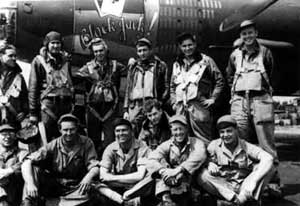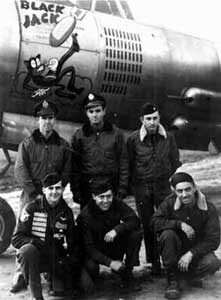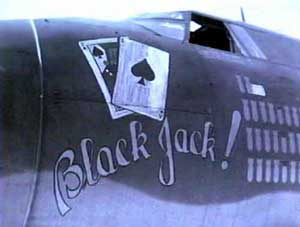|
|
Guest Book | Pages & Links |
Lt. William "Bill" C. Stuckey, Pilot,
394th Bomb Group, 587th Squadron
|
Lt. Bill Stuckey at his "luxury" quarters, Venlo, Holland. Summer, 1945. |
Cadet William "Bill" C. Stuckey, Jr., Class 44D, |
|
|
|
This photo shows part of the graduating class of 44D at Lubbock, Texas, April 15, 1944. |
|
|
|
B-26 on hard stand, getting checkover. |
This photo shows Lt. Stuckey and crew |
|
|
Crew of 2nd Lt. William Stuckey, Lake Charles, LA., November 1944. From left to right they are Lt. William Stuckey, Pilot; F/O John Elliot, Co-Pilot; F/O John Rakolta, Bombardier/Navigator; Cpl. Norman Spotts, Engineer/Gunner; Cpl. Earl Petrie, Radio/Gunner; James Smith, Armorer/Gunner. This crew arrived at the 394th Bomb Group, 587th Squadron at Cambrai, France in late February 1945. In the last one and one-half months before V-E Day, with the exception of Flight Officer Rakolta (who was replaced by an enlisted togglier), they started in approximately one-third of the missions flown by the 394th, completing 17 successful drops on the target, flying one mission as a spare, aborting one mission due to mechanical failure, and flying two group call-back missions due to troop movements and target changes. |
|
|
|
"Nose Art" and one of my friends. |
Kitzingen, Germany after the move from Venlo |
Co-Pilot, John Elliott, as seen from the nose |
|
Lt. Bill Stuckey as "Officer Of The Day" at Tuilln Air Force Base, 60 miles east of Vienna, Austria, and deep in the Russian Occupational Zone. When the 387th Squadron of the 394th Bomb Group was deactivated in September, 1945, Lt. Stuckey was reassigned to Tulln AFB. There he was given the job of Post Quartermaster Officer as his primary duty. He continued in this job until returning to the USA in July, 1946. |
|
|
|
Life in the Woods, Venlo, Holland. Left to right: Bill Stuckey (back to camera), Bob Norton (sitting on ground), Joe Wabalus, and Hank Chouteau with the camera. |
Venlo, Holland. Lt. Louis Zuefle with a |
|
|
Remains of German aircraft, Tulln AFB, |
German Stuka Dive Bomber, Tulln AFB, |
Hi Mike;
I connected to the two links on B26.com as you suggested and was surprised you had gotten something I sent you on the website so quickly. My daughter was awed at seeing me on the Internet. I'm well pleased with what you did with that picture. I'm sure whatever else you do with the pictures will be great.
I hate to "rain on your parade" about the two pictures of Class 44D, Lubbock, Texas (Air Corps Pilots | Graduating Class, 44D, Lubbock, TX, April 15, 1944). Not all of those individuals were pilots of B26s as you have indicated by the captions at the top of each photo. Class 44D at Lubbock had a total of 349 students who graduated from flying school (April 15, 1944) and were commissioned as Officers and multi-engine pilots, having no specialty as to type of aircraft. This was like graduating from "High School". In other words they were not trained in any special operational or combat type aircraft at that point.
They were assigned, by choice or otherwise, throughout the Army Air Corps to serve its' needs at that moment (April 1944). Many went immediately to fill slots as copilots on B26s, B17s, B24s, C47s etc., crews being made up, or to fill empty slots on existing crews. For example, my best friend was immediately assigned as a copilot on a C47, shipped to Burma and was flying supplies to the Flying Tigers over the "Hump" into China inside of six weeks after graduating in Class 44D. My copilot came directly from multi-engine school (one similar to Lubbock), with no experience on B26s. In fact, none of my crew except for me, had ever been close to a B26 until they were assigned as my crew.
Many of the 349 students at Lubbock were fortunate, as I was, and were sent to transitional schools for training as pilots in specific types of aircraft such as P38, B25, B26 ,B17, B24, etc. (This was like going to college to get a degree in a specific vocational field). Lucky for me, I went to Del Rio, Texas, where I learned to fly the B26. Later my crew was assigned to me and we went to Lake Charles, La. for (RTU) replacement crew training prior to being sent overseas and assigned to the 394th Bomb Group.
So, coming back to the two photographs, the first one you had shows some of the students as Aviation Cadets ( A/C ) on the flight line at Lubbock prior to graduation day. This one includes Kenneth Carty, who was a classmate of mine (Class 44D), and went on to become a B26 pilot, and is the subject of the page you had on "Mountain Marauder", telling the story of the crew who flew the "southern route to north Africa, crashing in Wales and never making it into combat.
The photo I sent you shows some of the aviation cadets who have just graduated and are now Second Lieutenants. My guess is that probably one-third of Class 44D, Lubbock wound up in B26s, either as first pilots or copilots.
If you want to know the names of the individuals in the photo I sent you, I'll try to match them up. However, I cannot remember who went further to B26 pilot training. It has been too many years past. In view of what I have told you, you might want to change the captions on each of these two photographs.
Best Regards,
Bill Stuckey
March 19, 2002
To: Trevor Allen
From: William C. Stuckey
Hi Trevor,
Our recent correspondence has brought to mind a story, printed in the Marauder Thunder something last year. Unfortunately I have misplaced my copy. The issue included a picture of the three people from the 394th BG, 587th SQ., Gene Sidwell, Guy Zieglar, and one other person. Accompanying the picture was story about a piece of nose art and aircraft name painted on the port side armored fuselage of a B-26 in the 587th SQ. Maybe you can help me out with the name?
I am told that the original aircraft with this panel crash-landed on return from a mission. Apparently the ground crew liked the "art" and name so well that the panel was salvaged and placed on another B-26 in the SQ. It seems the panel was doomed, however. On a subsequent mission this second aircraft (lead ship) and a wing man collided in mid-air during formation join-up. I understand that only one crewman from the two aircraft survived.
Again the "nose art" panel was salvaged and placed on a third B-26 in the 587th SQ. In late March 1945, while leading a mission over Germany, this third aircraft was hit by flak and lost behind enemy lines. Parachutes were observed, and fortunately all crew member survived and were held as POW's until V-E Day. So the story of the "nose art" panel ended. But this is not the complete story. There is a parallel story to go along with the "nose art" panel. It happens that one of my crew members and myself were associated with this "panel" in a backhanded sort of way.
I, William C. Stuckey, was a replacement pilot coming into the 587th SQ. in the middle of February, 1945. Other members of the crew were John A. Elliott, co-pilot; John Raklta, bombardier-navigator; Norman R. Spotts, engineer-gunner; Earl W. Petree, radio-gunner; and James M. Smith, armour-gunner.
There was no space in the barracks for us three officers to share the same room, so I was put, separately, in a room with three strangers. One of them sort of took me "in-hand" to help me get acquainted around, and to learn the ropes. His name is Reuben Corbin. The other two officers in the room were his crew members.
After a few days of orientation I flew my first mission. This took place on February 24th, which happened to be the 200th mission for the 394th BG. Early the next morning (Feb. 25th) I was awakened by Corbin and his two crew members stirring around in preparation for an early morning mission. As they departed, Corbin tapped me on the shoulder and said "Go back to sleep Stuckey. We'll see you at lunch time". Of course, this was the day that Corbin and his wing man collided in mid-air at take-off ---- and both crews were lost. On this day, Corbin was flying the second plane to have the "nose art" panel.
The afternoon of this day I spent with the squadron intelligence officer sorting and packing the belongings of the three people that I had known for only a short while. As a 21 year old "new" member to the group, I quickly learned that this was not a game we were playing, but the "real stuff".
Soon after we joined the 587th squadron, the operations officer inquired as to how well my bombardier could navigate. I assured him that John Rakolta was very good and that I had all the confidence in the world in his abilities. Thus John was soon transferred out of my crew and trained as a lead navigator. Among others, he was assigned to the crew of Phinney, Zell, and Lane. On March 23rd, while on a mission over Germany, the lead aircraft, flown by this crew and John Rakolta (my ex-bombardier as navigator), was hit by flak and went down behind enemy lines. Fortunately all the crew personnel survived and were held as POW's. The aircraft they were flying on this days was the third and last B-26 to have the salvaged "nose art" panel. I guess by now you understand why I feel so closely associated to the story of the nose-art panel, and how it relates to my "growing up" from a 21 year old kid into a 21 year old man. And that is the rest of the story.
Best Regards,
Bill Stuckey
Bill,
Your story came through clear on the second attempt, and is now on record in my 587th BG file.
The removal of nose art from one B-26 to another was a regular practice with in the 394th. Bomb Group and across all four squadrons. In fact the 394th BG was unique in carrying out practices that no other B-26 Group did.
Now to your story, the nose art was "Black Jack" and the identities go as follows. The first was 42-107628 and the ship crash landed a Romilly, December 2, 1944, the pilot being Lt. Reubin E. Corbin. Next came 43-34228 which was the subject of the mid-air collision February 25, 1945. Again the pilot was Reubin Corbin, but this time there were no survivors. The last "Black Jack" was 44-67903 which was lost to Flak on March 23, 1945 with Lt. Harry W. Lane and crew.
So there is the story in a nutshell, short and to the point, however your letter now adds the human touch to the story.
Regards,
Trevor


